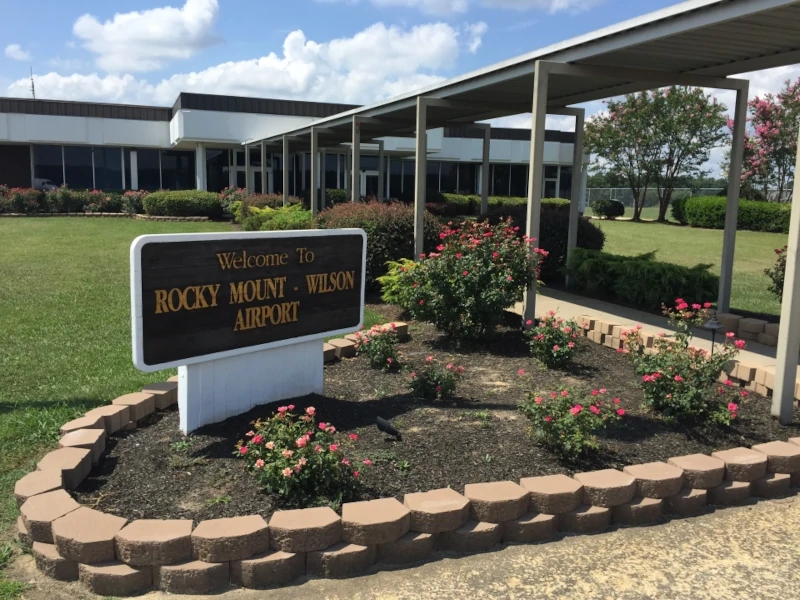Rocky Mount-Wilson Regional Airport
Taking off in 2024
Soaring to new heights in the heart of eastern North Carolina
Rocky Mount-Wilson Regional Airport is ideally situated between the dynamic counties of Nash, Wilson, and Edgecombe, in Eastern North Carolina’s Coastal Plains region. Operated by the Rocky Mount-Wilson Regional Airport Authority, the airport offers a friendly and safe atmosphere, proudly serving as a trusted resource for local and visiting aviators, while also planning for future opportunities.
“We are a general aviation airport,” elaborates Jarrett Moss, CFI, Interim Airport Director. “We had just over 47,000 flight operations last year, which was a huge increase in the last two to three years. And so, we’ve realized the growth, we’ve realized the growth potential, and now we’re in the planning stages of preparing for that future growth. And we’re very excited about it here.”

A Gateway to the Community
Positioned as a vital gateway to the surrounding communities, Rocky Mount-Wilson Airport finds itself amid an industrial boom and is actively preparing for its role. “Nash, Wilson, and Edgecombe counties are all tier one counties, with Nash County having the biggest industrial growth in the United States,” Moss details.
“We’re in a prime location. We are primed for success here at Rocky Mount. We want to make sure that all of our footwork is done, and all of our planning is done, so that way as soon as businesses decide to make Nash, Wilson, and Edgecombe counties their home, we’re ready for them. We’ll be able to accept them immediately. Whether that’s building them a new hangar or being a part of our future industrial park that we’re very excited about.”
Infrastructure Upgrades and Expansion
In line with this forward-thinking approach, Moss discusses the Airport Layout Plan (ALP) which is part of the larger master plan. He highlights the ongoing initiatives, including a partial parallel taxiway opposite the runway, with a significant ramp area. He notes that the Master Plan also shows the eventual development of a larger area, including the addition of hangars and office space. “Of course, our master plan is our next 10, 20, and 30 year plans. But we want it to reflect that, to show the growth that we could have,” he acknowledges.
A substantial addition to Rocky Mount-Wilson Airport’s capabilities is a newly acquired 20,000-gallon Jet A tank. Moss relays, “This tank was put in to meet the uptick in traffic that we’ve been seeing here at the airport. We’ve had instances where we were concerned that we may run out of fuel before we could get another field truck delivery, and so to meet that demand, and to also meet the next demand that we’re going to get, we’ve put in this Jet A tank.”
In addition to the Jet A tank, the airport is collaborating with the Division of Aviation on a project to rehabilitate the ramp. “They’re going to fix some of the joints in between the concrete slabs, as well as some deteriorating concrete in front of hangars four and five, where it’s starting to deteriorate. As well as our runway, they’re going to do the black outline painting, to outline all of the white markings on the runway to make it stand out a lot better,” Moss describes.
Preparing for Commercial Service
While currently a general aviation (GA) airport, Moss reveals the airport’s readiness for potential commercial service. “We make sure that we’re in the best possible position to be able to accept them at any time that we possibly can,” he maintains.
“This airport was purposely built in 1970 to be a commercial service airport. We lost airline service in 1999 due to a new law that stated 2 commercial service airports cannot be within 100 miles of each other.”
He points out that the airport has retained its Part 139 certification, adding, “Any type of charter commercial, if they ever wanted to come back, our airport is already certified. We’re good to go.”
Moss underscores the proactive measures taken to ensure flexibility in welcoming potential commercial airlines. Noting the ability to service airlines on a 24-hour notice, he says “We can service just about anybody give or take. Maybe not the biggest of the biggest, but we’ll be able to accommodate most of the regionals.”
Currently, the airport is involved in an obstruction removal project, aimed at clearing approach paths and enhancing the appeal to industries.
“The goal is to remove trees that have grown up around our approach paths and our airport. We’re going in and we’re cutting them down, and we’re grinding them down all the way to the ground and we’re seeding and mulching back on top of it to keep our property owners happy around us, and to protect our approaches,” Moss details. He says the project not only addresses safety concerns but also aims to prevent the FAA from raising minimums.
“We want it to be attractive to those types of industries. To show that we’re doing everything that we possibly can to make this airport as attractive as possible to make that business want to come and be a part of our airport.”

Safety, Training, and Maintenance Needs
Recognizing the aviation employee shortage, especially in terms of pilots and mechanics, Moss emphasizes the airport’s efforts in flight training. FLY-RWI, Rocky Mount-Wilson Airport’s flight school has seen success in producing new pilots.
“Basically, we’re meeting the demand of people in the surrounding areas who want to learn how to fly. They’re coming to our flight school and learning that passion. I carry that same passion as well because I’m a flight instructor here in the field, and I work for that company as a flight instructor. It’s great to see these new pilots that are interested in aviation to help meet that demand,” he recounts.
In addition, Bass Aviation, responsible for airport maintenance, is actively recruiting mechanics to meet the growing need amid Rocky Mount Wilson’s growth.
In 2021, the airport recorded 10,200 operations, which skyrocketed to 29,700 in 2022, and an astounding 45,800 in the following year. Moss attributes a significant portion of this surge to Blueline Aviation, a flight school in Johnston County.
He reports, “We’re seeing a lot of traffic because they’re such a big flight school there, they are congesting the traffic pattern over Johnston County. And so, to find other places nearby, they’ll come to our airport. Of course, we try to have the cheapest fuel around, and that gives them another incentive to come to our airport.”
On the safety side, Rocky Mount-Wilson goes above and beyond standard safety measures, implementing ID badging for tenants, pilots, and employees, along with trained drivers to ensure a secure and controlled environment.
“Anybody that is authorized, or that would need access to the ramp area, or the T-hangars, they have all been trained in driver training on airport grounds, limiting any type of incidents regarding conflict between aircraft and vehicles. And then, anybody that is being escorted through the gate, if they are not driver trained, they must be escorted by airport personnel,” says Moss.
“That’s one way that we have increased our security measures, just by taking that one extra step. GA airports usually are not held to that standard, and we’re not held to that standard either. But we’d like to set the precedents here.”
A Future Vision
Moss’s personal aviation journey began at the age of thirteen when he went on his very first plane ride, which happened to be at Rocky Mount-Wilson Airport.
“As soon as the wheels left the pavement I said, this is amazing, this is exactly what I want to do. Ever since then, the aviation bug hooked me. I knew from that point on exactly what I wanted to do. And I made sure every decision that I made along the way, landed me a job in aviation,” he recollects.
As the Rocky Mount-Wilson Regional Airport charts its course for 2024, plans are underway to address the growing demand for hangar space. The proposed construction of T-hangars and box-style facilities reflects the airport’s commitment to accommodating its growing list of tenants and clients.
Moss conveys, “I have a waiting list that’s over 20 people long that are requesting a T-hangar. So, the demand is there. Now we just have to meet it.”
AT A GLANCE
Rocky Mount-Wilson Regional Airport
What: A vibrant general aviation airport experiencing remarkable growth
Where: Elm City, North Carolina
Website: www.krwiairport.com




